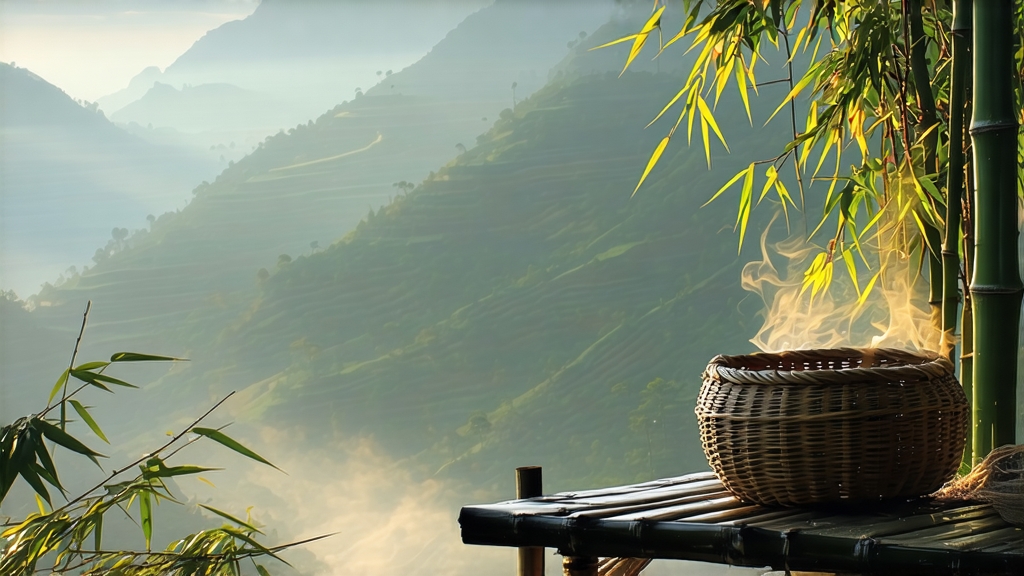
Tucked high on the mist-laden slopes of Mt. Meng in Sichuan Province, Meng Ding Huang Ya has been whispered about in Chinese tea texts for more than twelve centuries. Legend claims that the Daoist monk Wu Lizhen planted the first seven bushes on the summit in 53 BCE; by the Tang dynasty (618-907) those bushes were taxed as “imperial tribute,” carried in silk-lined baskets down the Min River to Chang’an for the Son of Heaven alone. Foreign merchants who later traveled the Tea-Horse Road tasted the tea at frontier markets and recorded a “yellow liquor that smells of winter bamboo and sweet corn,” the earliest written hint of a category we now call yellow tea. While the West has celebrated green, black and pu-erh, the yellow family—only three major traditional styles survive—has remained a guarded secret, and Meng Ding Huang Ya is its most luminous representative.
What makes a tea “yellow”? It is not leaf color alone but an extra, labor-intensive step known as men huang—“sealing yellow.” After the buds are pan-fired to kill green enzymes, they are wrapped while still warm in thick paper or hemp cloth and left to breathe in bamboo crates for 48–72 hours. During this micro-fermentation the leaf re-absorbs its own moisture, chlorophyll breaks down, catechins oxidize slightly, and amino acids convert into mellow, chestnut-sweet compounds. The result is a liquor that tastes halfway between the grassy snap of spring green tea and the honeyed depth of a light oolong, yet belongs to neither tribe.
Meng Ding Huang Ya is harvested only ten mornings each year, when the mountain fog is so dense that sunlight never scorches the tender tips. Pickers climb 1,400 m above the Ya’an valley before dawn, selecting only the unopened bud plus the first half-centimetre of stem—specimens so small that a kilo of finished tea needs 80,000 pluckings. The leaf is then “three-times fired, three-times wrapped,” a rhythm unchanged since Song dynasty workshops kept records on bamboo slips. First wok-roasting occurs at 160 °C for four minutes, just enough to halt oxidation; the hot leaf is immediately piled in linen sacks and left to sweat. The cycle repeats twice more, each time with lower temperatures and longer wraps, coaxing out the golden hue and signature “cooked rice” aroma. Finally the master roaster rolls the buds on a bamboo tray above charcoal embers so gentle that a hand can hover two inches from the surface for five seconds without pain. This “soft fire” fixes the fragrance and reduces moisture to 4 %, allowing the tea to travel for months without losing soul.
Western tea lovers often confuse the process with light oxidation, yet chemical analysis shows that Meng Ding Huang Ya’s polyphenol level drops only 8–10 %, far less than the 30–50 % seen in oolong. Instead, the key change is non-enzymatic: Maillard reactions during the wrapped rests create pyrazines and furans that deliver toasted sesame and popcorn notes. The finished bud is slim and straight, the colour of wheat straw shot with emerald veins; when viewed against the light it is semi-translucent, as though lacquered by the mountain’s own humidity.
To brew the tea respectfully, use still spring water just off the boil (85 °C). Pre-warm a tall glass or a 150 ml gaiwan; drop 3 g of buds—roughly two teaspoons—into the bottom. The first infusion, 45 seconds, unfurls the tips like miniature flags; the liquor glows pale primrose and smells of fresh bamboo split under the moon. Sip slowly, letting the tea coat the tongue from front to back; you will taste sweet corn milk at the tip, then a snap of snow pea in the mid-palate, finishing with a faint mineral echo of wet slate. Second infusion, 30 seconds, brings out orchid and a touch of salted butter; third infusion, 50 seconds, is creamier, like rice pudding scraped from the bottom of a bamboo steamer. Good leaves yield five steeps, but the third is traditionally considered the “imperial cup,” the moment when leaf and water achieve perfect equilibrium.
Professional cupping follows a quieter choreography. Five grams are placed in a 110 ml white porcelain set; water at 90 °C is poured to the rim and covered for